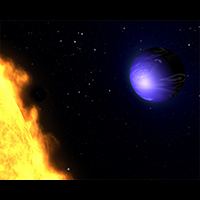The number of exoplanets known to us is ever growing; planet HD 189733b is the most blue of them all. Although when viewed through the Hubble space telescope this planet appears to be a beautiful blue planet, the environment is treacherous for human life. This planet is classified as a "hot Jupiter", with a mass that is 16.2% larger than Jupiter's, and a radius 13.8% wider. HD 189733b has an incredible orbital speed of 152.5 kilometers per second, 5 times faster than that of Earth. This speedy gas giant orbits its star HD 189733 in just 2.2 Earth days, (52 hours). The speed of the orbit is due to how close this planet orbits its star. It is only 2.9 miles from its parent star, which is much closer than Venus (33.8 million miles) is to our star. This is so close that HD 189733b is tidally locked, meaning that the same side of the planet is always facing its star. Another side effect of this very short distance is actually the deep blue color of the planet. Unlike Earth, where the blue is caused by the presence of oceans, HD 189733b is blue because of its 2,000 degree Fahrenheit atmosphere. This planet is beautiful, but it is also deadly.

The orbital speed of the planet is not the only aspect that is incredibly fast. HD 189733b has been observed to have winds of up to 5,400 mph. This is seven times the speed of sound. To further put this into perspective, the fastest tornado on Earth ever recorded was only 302 mph in 1999 in Oklahoma. If a human were to be dropped on HD 189733b they would be tossed around like a flower in the wind. Combining this wind with the harsh rain of the planet creates storms that can be compared to a rain of glass, blowing at 7 times the speed of sound.

HD 189733b is The True Blue Planet, but sadly, the same reasons that make it blue make it truly uninhabitable for humans.
Sources
https://www.nasa.gov/image-feature/rains-of-terror-on-exoplanet-hd-189733b
https://en.wikipedia.org/wiki/HD_189733_b
https://exoplanets.nasa.gov/resources/139/nasas-hubble-finds-a-true-blue-planet/
Can you explain a bit more how the temperature of the planet makes it this bright blue color? Is the color due to solely the temperature of the atmosphere or does the temperature cause certain solids to vaporize and those particles are what reflect light from the star and give it this blue color?
ReplyDelete